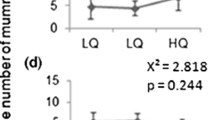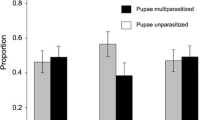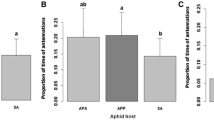Abstract
Mate finding and dispersal from the natal patch in parasitoid Hymenoptera are influenced by the availability of host resources and interactions with other organisms. We compared the mating behavior of three solitary aphid parasitoids, Aphidius ervi Haliday, Lysiphlebus hirticornis Mackauer and Pauesia pini (Haliday) (Hymenoptera: Braconidae: Aphidiinae) that differ in host resource exploitation and ant mutualism. In L. hirticornis, which is obligately ant-attended, the residence time on the natal patch was approximately 4 h compared with less than 2 h in the facultatively ant-attended P. pini; the sexes did not differ in residence time. Females of A. ervi, which is not attended by ants, stayed for slightly more than 2 h on the natal patch while their male siblings remained for only 1 h. In L. hirticornis, 90% of all siblings in a clutch mated on the natal patch but only 13% in A. ervi and 42% in P. pini did so. Off-patch matings (23%) were observed only in A. ervi. Males and females of L. hirticornis were 12-times more likely to mate on the natal patch when aphids and ants were present than when either of the latter species was removed; and patch residence time declined from approximately 4 h to approximately 2.5 h in the absence of either aphids or ants. We propose that, in aphidiine wasps and perhaps other quasigregarious parasitoids, mating behavior is influenced by the availability of resources on the natal patch and the presence or absence of trophobiotic ants. Partial sib mating is expected in species producing large clutches and having a long patch residence time.






Similar content being viewed by others
References
Abe J, Kamimura Y, Kondo N, Shimada M (2003) Extremely female-biased sex ratio and lethal male-male combat in a parasitoid wasp, Melittobia australica (Eulophidae). Behav Ecol 14:34–39
Addicott JF (1978) Competition for mutualists: aphids and ants. Can J Zool 56:2093–2096
Battaglia D, Isidoro N, Romani R, Bin F, Pennacchio F (2002) Mating behaviour of Aphidius ervi (Hymenoptera: Braconidae): the role of antennae. Eur J Entomol 99:451–456
Belshaw R, Quicke DLJ (2003) The cytogenetics of thelytoky in a predominantly asexual parasitoid wasp with covert sex. Genome 46:170–173
Braendle C, Weisser WW (2001) Variation in escape behavior of red and green clones of the pea aphid. J Insect Behav 14:497–509
Buckley RC (1987) Interactions involving plants, Homoptera, and ants. Ann Rev Ecol Syst 18:111–135
Cameron PJ, Powell W, Loxdale HD (1984) Reservoirs for Aphidius ervi Haliday (Hymenoptera: Aphidiidae), a polyphagous parasitoid of cereal aphids (Hemiptera: Aphididae). Bull Entomol Res 74:647–656
Clegg JM, Barlow CA (1982) Escape behavior of the pea aphid Acyrthosiphon pisum (Harris) in response to alarm pheromone and vibration. Can J Zool 60:2245–2252
Cook JM (1993) Sex determination in the Hymenoptera: a review of models and evidence. Heredity 71:421–435
Crawley MJ (2007) The R Book. Wiley, West Sussex
Doyon J, Boivin G (2005) The effect of development time on the fitness of female Trichogramma evanescens. 5
Fellowes MDE, Compton SG, Cook JM (1999) Sex allocation and local mate competition in old world non-pollinating fig wasps. Behav Ecol Sociobiol 46:95–102
Fischer MK, Hoffmann KH, Völkl W (2001) Competition for mutualists in an ant-homopteran interaction mediated by hierarchies of ant attendance. Oikos 92:531–541
Flatt T, Weisser WW (2000) The effects of mutualistic ants on aphid life history traits. Ecology 81:3522–3529
Godfray HCJ (1994) Parasitoids: behavioral and evolutionary ecology. Princeton University Press, Princeton
Godfray HCJ, Cook JM (1997) Mating systems of parasitoid wasps. In: Choe JC, Crespis BJ (eds) The evolution of mating systems in insects and arachnids. Cambridge University Press, Cambridge, pp 211–225
Grillenberger BK, Van De Zande L, Bijlsma R, Gadau J, Beukeboom LW (2009) Reproductive strategies under multiparasitism in natural populations of the parasitoid wasp Nasonia (Hymenoptera). J Evolution Biol 22:460–470
Gu HN, Dorn S (2003) Mating system and sex allocation in the gregarious parasitoid Cotesia glomerata. Anim Behav 66:259–264
Hamilton WD (1967) Extraordinary sex ratios. Science 156:477–488
Hardy ICW (1994) Sex ratio and mating structure in the parasitoid Hymenoptera. Oikos 69:3–20
Hardy ICW (2002) Sex ratios: concepts and research methods. Cambridge University Press, Cambridge
Kaneko S (2003) Different impacts of two species of aphid-attending ants with different aggressiveness on the number of emerging adults of the aphid’s primary parasitoid and hyperparasitoids. Ecol Res 18:199–212
King BH (1987) Offspring sex ratios in parasitoid wasps. Q Rev Biol 62:367–396
Lebreton S, Chevrier C, Darrouzet E (2010) Sex allocation strategies in response to conspecifics’ offspring sex ratio in solitary parasitoids. Behav Ecol 21:107–112
Liepert C, Dettner K (1993) Recognition of aphid parasitoids by honeydew-collecting ants: the role of cuticular lipids in a chemical mimicry system. J Chem Ecol 19:2143–2153
Loch AD, Walter GH (2002) Mating behavior of Trissolcus basalis (Wollaston) (Hymenoptera: Scelionidae): potential for outbreeding in a predominantly inbreeding species. J Insect Behav 15:13–23
Mackauer M (1976a) Sex ratio in field populations of some aphid parasites. Ann Entomol Soc Am 69:453–456
Mackauer M (1976b) An upper boundary for the sex ratio in a haplodiploid insect. Can Entomol 108:1399–1402
Mackauer M, Henkelman DH (1975) Effect of light-dark cycles on adult emergence in aphid parasite Aphidius smithi. Can J Zool-Rev Can Zool 53:1201–1206
Mackauer M, Starý P (1967) World Aphidiidae (Hymenoptera: Ichneumonoidea). Le François, Paris
Mackauer M, Völkl W (1993) Regulation of aphid populations by aphidiid wasps: does parasitoid foraging behavior or hyperparasitism limit impact? Oecologia 94:339–350
Mackauer M, Völkl W (2002) Brood-size and sex-ratio variation in field populations of three species of solitary aphid parasitoids (Hymenoptera: Braconidae, Aphidiinae). Oecologia 131:296–305
Mahmoudi M, Sahragard A, Sendi JJ (2010) Foraging efficiency of Lysiphlebus fabarum Marshall (Hymenoptera: Aphidiidae) parasitizing the black bean aphid, Aphis fabae Scopoli (Hemiptera: Aphididae), under laboratory conditions. J Asia-Pac Entomol 13:111–116
Martel V, Boivin G (2007) Unequal distribution of local mating opportunities in an egg parasitoid. Ecol Entomol 32:393–398
Martel V, Wajnberg E, Boivin G (2008) Patch time allocation in male parasitoids. Ecol Entomol 33:608–613
McClure M, Whistlecraft J, Mcneil JN (2007) Courtship behavior in relation to the female sex pheromone in the parasitoid, Aphidius ervi (Hymenoptera: Braconidae). J Chem Ecol 33:1946–1959
McNeil JN, Brodeur J (1995) Pheromone mediated mating in the aphid parasitoid, Aphidius nigripes (Hymenoptera: Aphididae). J Chem Ecol 21:959–972
Mishra S, Singh R (1991) Sex ratio of the aphid parasitoid Lysiphlebus delhiensis (Subba Rao and Sharma) (Hymenoptera: Aphidiidae) in field population. J Appl Entomol 111:72–77
Myint WW, Walter GH (1990) Behaviour of Spalangia cameroni males and sex ratio theory. Oikos 59:163–174
Nadel H, Luck RF (1992) Dispersal and mating structure of a parasitoid with a female-biased sex ratio: implications for theory. Evol Ecol 6:270–278
Nazzi F, Powell W, Wadhams LJ, Woodcock CM (1996) Sex pheromone of aphid parasitoid Praon volucre (Hymenoptera, Braconidae). J Chem Ecol 22:1169–1175
Nyabuga FN, Loxdale HD, Heckel DG, Weisser WW (2010) Spatial population dynamics of a specialist aphid parasitoid, Lysiphlebus hirticornis Mackauer (Hymenoptera: Braconidae: Aphidiinae): evidence for philopatry and restricted dispersal. Heredity 105:433–442
Pompanon F, Fouillet P, Bouletreau M (1995) Emergence rhythms and protandry in relation to daily patterns of locomotor activity in Trichogramma species. Evol Ecol 9:467–477
Quicke DLJ (1997) Parasitic wasps. Chapman and Hall, London
R Development Core Team (2008) R: a language and environment for statistical computing. R Foundation for Statistical Computing, Vienna
Schwörer U, Völkl W (2001) Foraging behavior of Aphidius ervi (Haliday) (Hymenoptera: Braconidae: Aphidiinae) at different spatial scales: resource utilization and suboptimal weather conditions. Biol Control 21:111–119
Sequeira R, Mackauer M (1993) Seasonal variation in body size and offspring sex ratio in field populations of the parasitoid wasp, Aphidius ervi (Hymenoptera: Aphidiidae). Oikos 68:340–346
Sigmaplot (2008) SigmaPlot for windows version 11.0. Systat Software Inc.
Singh R, Pandey S (1997) Offspring sex ratio in Aphidiinae (Hymenoptera: Braconidae): a review and bibliography. J Aphidology 11:61–82
Sokal RR, Rohlf JF (1995) Biometry. W. H. Freeman and Company, New York
Srivastava M, Singh R (1995) Influence of age of parents Lysiphlebus delhiensis (Subba-Rao and Sharma) (Hym., Aphidiidae) during copulation on progeny production and offspring sex ratio. J Appl Entomol 119:73–77
Stadler B, Dixon AFG (1999) Ant attendance in aphids: why different degrees of myrmecophily? Ecol Entomol 24:363–369
Starý P (1973) A review of the Aphidius species (Hymenoptera: Aphidiidae) of Europe Annot. Zool Botanicae 85:1–85
Starý P (1999) Biology and distribution of microbe-associated thelytokous populations of aphid parasitoids (Hym., Braconidae, Aphidiinae). J Appl Entomol 123:231–235
Starý P (2006) Aphid parasitoids of the Czech Republic (Hymenoptera: Braconidae: Aphidiinae). Academia, Prague
Takada H, Tada E (2000) A comparison between two strains from Japan and Europe of Aphidius ervi. Entomol Exp Appl 97:11–20
Van Den Assem J (1977) A note on ability to fertilize following insemination (with females of Nasonia vitripennis, Hym.: Chalcidoidea). Neth J Zool 27:230–235
Van Den Assem J, Gijswijt MJ, Nubel BK (1980) Observations on courtship strategies and mating strategies in a few species of parasitic wasps (Chalcidoidea). Neth J Zool 30:208–227
Völkl W (1994) The effect of ant-attendance on the foraging behavior of the aphid parasitoid Lysiphlebus cardui. Oikos 70:149–155
Völkl W (1997) Interactions between ants and aphid parasitoids: patterns and consequences for resource utilization. In: Dettner K, Bauer G, Völkls W (eds) Vertical food web interactions. Springer, Berlin, pp 225–240
Völkl W, Novak H (1997) Foraging behaviour and resource utilization of the aphid parasitoid, Pauesia pini (Hymenoptera: Aphidiidae) on spruce: influence of host species and ant attendance. Eur J Entomol 94:211–220
Völkl W, Woodring J, Fischer M, Lorenz MW, Hoffmann KH (1999) Ant-aphid mutualisms: the impact of honeydew production and honeydew sugar composition on ant preferences. Oecologia 118:483–491
Völkl W, Mackauer M, Pell JK, Brodeur J (2007) Predators, parasitoids and pathogens. In: Van Emden HF, Harrington R (eds) Aphids as crop pests. CAB International, London, pp 187–233
Weisser WW (1995) Within-patch foraging behavior of the aphid parasitoid Aphidius funebris: plant architecture, host behavior, and individual variation. Entomol Exp Appl 76:133–141
Weisser WW (2000) Metapopulation dynamics in an aphid-parasitoid system. Entomol Exp Appl 97:83–92
West SA, Herre EA (1998) Partial local mate competition and the sex ratio: a study on non-pollinating fig wasps. J Evol Biol 11:531–548
Wrensch DL, Ebbert MA (1993) Evolution and diversity of sex ratio in insects and mites. Chapman and Hall, New York
Acknowledgements
FNN thanks the Deutscher Akademischer Austausch Dienst (DAAD) for financial support. US was supported by a grant of the German Research Council (DFG, Vo 628/3-1,2). We also thank two anonymous reviewers for providing helpful editorial comments on the manuscript.
Author information
Authors and Affiliations
Corresponding author
Rights and permissions
About this article
Cite this article
Nyabuga, F.N., Völkl, W., Schwörer, U. et al. Mating Strategies in Solitary Aphid Parasitoids: Effect of Patch Residence Time and Ant Attendance. J Insect Behav 25, 80–95 (2012). https://doi.org/10.1007/s10905-011-9279-3
Revised:
Accepted:
Published:
Issue Date:
DOI: https://doi.org/10.1007/s10905-011-9279-3




